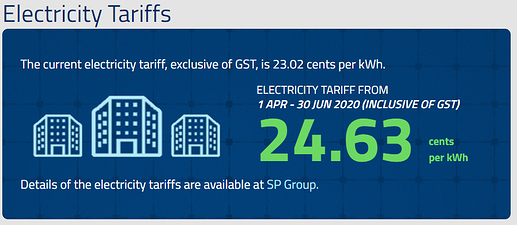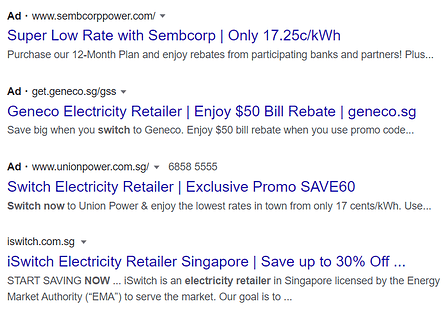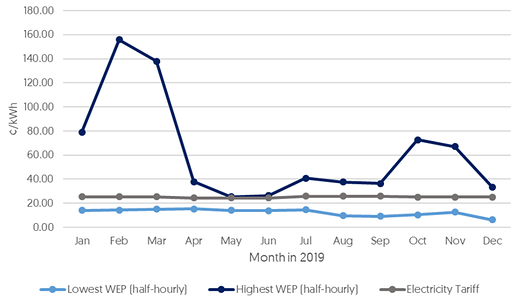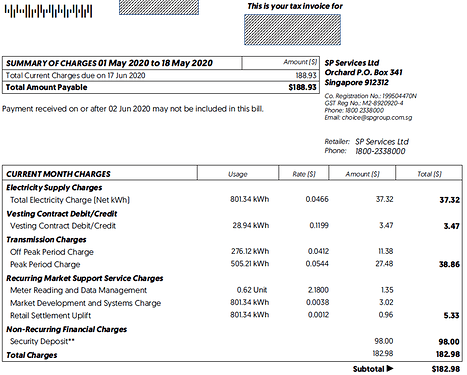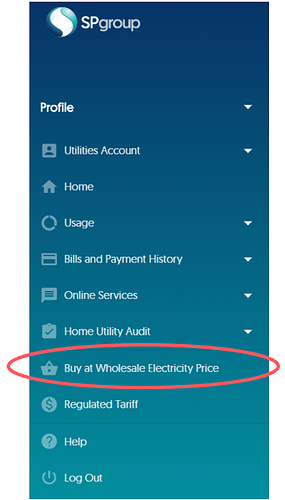The Open Electricity Market
As of 2020, the Singapore Open Electricity Market has already been around for several years. It is an effort to increase competition in country’s electricity market by allowing third party retailers to enter the market and sell electricity to Singaporean households and businesses - breaking up what was before that a monopoly run by the venerable SP Group, a government-owned company.
These days, besides SP Group, there are a raft of other retailers where Singaporean homeowners can buy their electricity from. There are a total 12 approved retailers, which include names such as Geneco, Keppel Electric, Tuas Power who are all offering their own (very similar) electricity plans that you can sign up for.
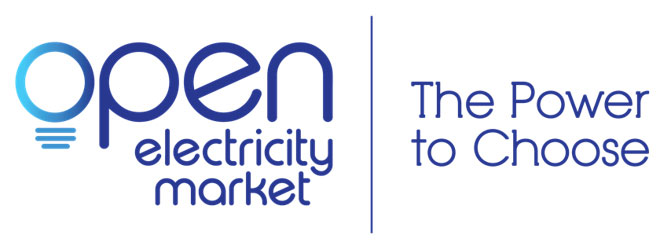
With great POWER… comes great responsbility to choose wisely! 
Unless you have been hiding under a rock (and avoiding all the electricity retailer salespeople as if they have COVID), most homeowners would be acutely aware of the “sure save money” action of changing from SP (the default for all everyone) to one of these Open Electricity Market Retailers in Singapore. The value proposition quite simple:
- By default, SP Group provides power to everyone at the regulated tariff rates. These are decided by the government regulator Energy Market Authority (EMA), and adjusted quarterly to provide relative stable pricing to Singaporean households. The latest price for the period of 1 Apr-30 June 2020 is 24.63 cents/kWH as taken from the EMA webpage
- Electricity retailers offer power to you at the regulated tariff WITH an added discount. In addition, they also often throw in other freebies and rebates if you commit to a long-term contract with them. For example, the current best available offers as of June 2020 seem to be around 20+% discount off the regulated tariff rates depending on the length of the contract. Besides the regulated tariff + discount, retailers also offer other packages such as fixed rates, but just like the market for home mortgages, the fixed rates is generally slightly higher than the forecast floating rates to compensate the retailer for bearing the extra uncertainty.
A sample of ads from electricity retailer ads on Google, you can see the aggressive discounts/low rates they are offering as compared to the regulated tariff
Since every electricity retailer will offer you a package that is a certain percentage discount off the regulated tariff rate, it seems like a no-brainer for everyone to change to a 3rd party retailer right - switch from SP to [insert your preferred retailer here] and get an immediate 20% savings!
Well that was honestly what I thought as well, until I decided to dig further into the electricity market and all the available rates and options as part of my own search for the best electricity retailer for my upcoming house - we don’t only do thorough analyses for choosing the best credit cards! 
What I found is that there is actually a much less known rate that you could be using - the Wholesale Tariff rates which are currently only offered by SP. Wholesale tariffs are much less well-marketed and well-known than the regulated tariffs, which is a waste because it is a potential way to save on your electricity bills if you can deal with some additional risk.
So how are Wholesale Tariffs different from Regulated Tariffs?
Wholesale tariffs are the rates that electricity retailers pay to purchase electricity in bulk from the power generation companies to then re-sell to homeowners. These prices are based on the actual demand-supply in the electricity market, and are updated every 30 minutes. The full name for it is the Uniform Singapore Energy Price (USEP), and you can look up historical data from the Energy Market Company
Like anything bought in bulk, wholesale prices are usually lower than the regulated tariffs, but in exchange you are subject to more uncertainty because the prices are updated every 30 mins as opposed to every 3 months if you are on the regulated tariffs.
While this is typically not a major issue, it can spike rapidly in the case of unexpected issues in power demand-supply. For example - in Feb 2019, prices ranged from 14.32 cents/kWh to a whopping 155.83 cents/kWh due to unexpected power outage. You can see the range of prices for 2019 in the chart below provided by SP, where WEP = Wholesale Electricity Price.
Having just gone through a refinancing for my house recently, I think a mortgage analogy could be helpful here: Wholesale rates are like SIBOR-linked mortgages - they change quickly in response to real-time demand/supply, while regulated tariffs are more similar to internal board rates mortgages - slightly more stable in that it doesn’t change daily/weekly, but it still subject to the same market forces and will eventually have to go up/down in response to market interest rates.
Benefits of using SP wholesale rate
On a regular day/month, the wholesale prices are cheaper than the regulated tariff, however this of course comes with extra risk if there is any sudden changes in electricity demand/supply. But how much cheaper can wholesale rates actually be?
@dexter.tiah is actually currently on the SP wholesale rates so we can use his actual SP invoice for latest partial month of May as an example
There are many different cost items in his bill, but to get a simple aggregate view we just focus on his total electricity consumption versus total bill charges. Excluding the one-off security deposit of $98, his effective electricity price for the time period of this bill is 10.6cents/kWH (Usage of 801.34 kWh, charges of $84.96), which is significantly below the current best available “discounted” tariff rates of ~17-18cents/kWh offered by other electricity retailers. And these rates are subject to you signing up for a contract that is anywhere from 6 to 24 months long, locking you in for that time period
In contrast, the wholesale rate under SP has no contract - you can freely change back to the regulated tariff or one of the other electricity retailers any any time with no penalties whenever you find that that the wholesale rates are no longer to your liking. Pretty great deal to be honest!
If you are interested in more details on the wholesale electricity prices from SP, you can check out their website and product factsheet
How do I switch to SP wholesale electricity rates?
If you are currently still with SP Group (i.e. you have not signed up with any of the 3rd party retailers), you can easily make the switch on the SP Utilities Portal.
Screenshot from SP portal
If you are currently with another electricity retailer then it gets a bit more difficult. First, you have to be clear of any locked-in contract otherwise there will be a penalty charges. (@dexter.tiah paid the penalty charges when switching out from Geneco). If you are not under any contract, you can then contact your electricity retailer and tell them that you want to quit and return to SP (which is always the default provider as long as you do not have any other retailer serving you). Once you are back under SP, you can then make the switch the wholesale electricity plan on the SP portal.
From what we have heard and personally experienced, the process is quite straightforward for apartments, but gets a little bit complicated for landed properties with solar panels. If you are living in a landed property, you may want to escalate this by emailing SP Group!
Summary
On the whole, the SP wholesale electricity plan appears to be very attractive as long as you make sure you understand what you are getting into and the potential added risks due to more variable pricing.
From what we have seen on the pricing, wholesale electricity prices gives a lower overall monthly electricity bill on average, except in situations where there is unexpected outages and the prices shoot up. Even in these cases, the period of time where prices are high are quite short and don’t impact your bill that much.
My personal take it is extremely unlikely for wholesale prices to be significantly higher than the regulated tariff for any extended period of time. If you as a single household using wholesale rates feel some pain (paying much more on your wholesale rates vs regulated tariff), just imagine whats happening to the open market electricity retailers in such a situation - they would be buying electricity at higher prices than the price they are selling at, across tens/hundreds of thousands of households! This would quickly result in an unsustainable situation that has be be resolved by wholesale rates either coming down, or regulated tariffs increasing to make the economics for electricity retailers work out.
Would definitely encourage anyone who is interested to read up more about the wholesale rates on the SP website and take advantage of this if it makes sense for you!
Note: This might sound like one, but it’s actually NOT a sponsored post. We are just personally excited to share potential good opportunities/deals to save money with all our readers 
If you would like to get the maximum rewards from your credit cards, do consider integrating WhatCard into your lifestyle to help you optimize your credit card rewards, and follow us on Facebook to stay updated on the latest tips, tricks, and hacks (like this article!) to get the most out of your credit cards
If you enjoyed this article, you may also be interested in:
- Why I'm still using my YouTrip card during CB
-
What is the value of a mile in the post Covid-19 world?
Pros and cons of keeping your savings in your CPF Special Account (SA) - Anatomy of the real responsible investing firm
- WhatCard’s list of best credit card sign up promotions
- Why do so many people continue to use their EZ-Link cards for MRT/Bus payments? !

